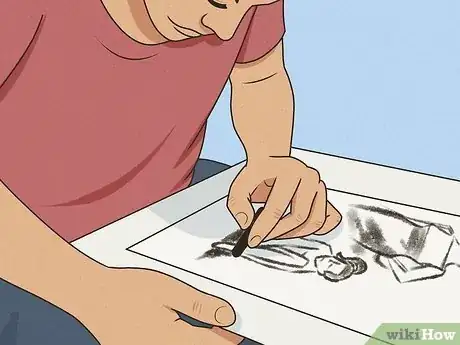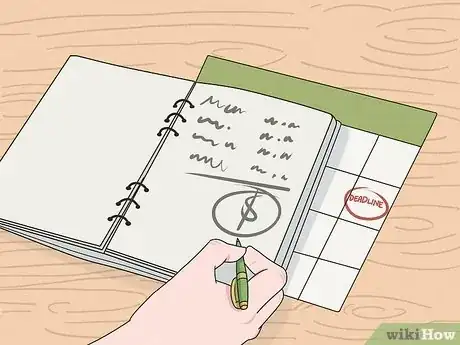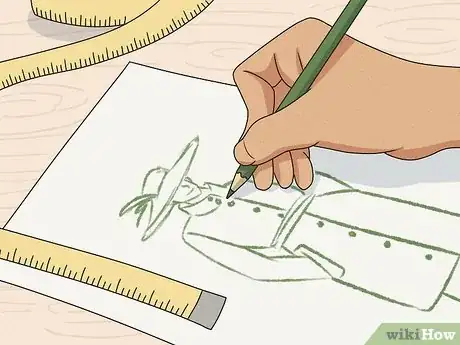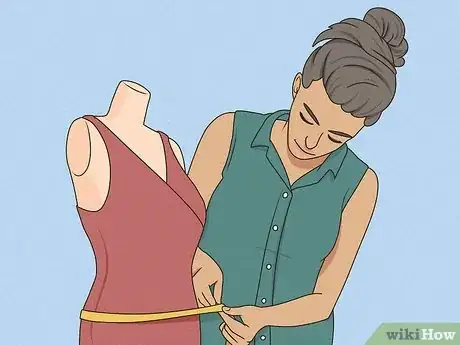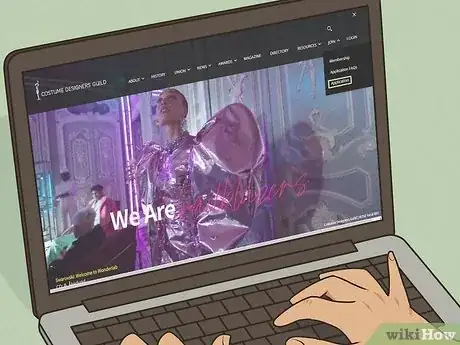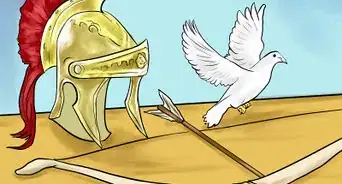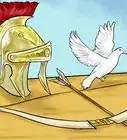This article was co-authored by wikiHow Staff. Our trained team of editors and researchers validate articles for accuracy and comprehensiveness. wikiHow's Content Management Team carefully monitors the work from our editorial staff to ensure that each article is backed by trusted research and meets our high quality standards.
This article has been viewed 52,605 times.
Learn more...
Costume designers envision and create the outfits worn in plays, movies, TV shows, dance concerts, and more.[1] Their artistic touch contributes greatly to how audience members perceive characters. While this profession requires a lot of hard work, those with a creative eye can do really well in it. If you want to become a costume designer, get design experience, build a skill set, and then start your career.
Steps
Getting Design Experience
-
1Observe and analyze costumes in plays and movies. While it would be great to attend plays and watch a lot of TV and movies for your personal enjoyment, having a more critical eye will help you start understanding costume design. Make note of the colors of costumes and the materials they’re made out of, and practice recognizing factors that influence these decisions.
- Time periods and character personalities are just a couple of the different factors that influence costume design.
-
2Volunteer at a local theater or film set. Do whatever you can to expose yourself to a costume designing environment. This can mean being an unpaid backstage helper at a local theater or working on a project with the film club at the school you attend. Keep taking these opportunities while also applying for internships and entry level jobs that can potentially get your foot in the door.[2]Advertisement
-
3Get a relevant degree. Each employer has different educational standards, but you’ll most likely need at least an associate’s degree to have a shot at entry level employment. While getting a costume design degree, you’ll learn about drawing, tailoring, fashion history, stage makeup, pattern design, and more.[3]
- You can also get into costume design with a degree in graphic design, visual art, or fashion design.
- If you’d like to get a Bachelor’s or Master’s degree, this will only improve your value and skill set.
-
4Put together a portfolio of your work. Having a solid portfolio is essential if you want to start a career in costume design. Potential employers are going to want to see proof of your creativity and design skills. It’s best to have your portfolio in more than one format.
- Consider having both an online version and a photographic version of your portfolio.[4]
Building a Skill Set
-
1Expand your artistic abilities. While design itself doesn’t require that you be flawless with a sewing machine or phenomenal at drawing, building skills in relevant artistic areas such as these will make it that much easier to properly execute your costume ideas. Practicing these creative skills can also teach you to pay attention to detail and develop a better awareness of the world around you.
-
2Develop good research skills. While the overall goal of costume design is to design, you can’t do that unless you first develop a thorough understanding of who is wearing the costume and why they’re wearing it. Study the characters forwards and backwards before you start the designing process.
- It’s helpful to have specific references to become inspired by and base your vision on.[5]
-
3Work on your communication skills. Good communication skills are absolutely vital to efficiently designing and creating costumes.[6] You’re the one with the vision, and you’re the one who will have to communicate that vision to others clearly and effectively in order to have a strong end product.
- As a designer, you’ll often be in a leadership position where you rely on others’ help.[7] Whenever you find yourself in this role, do your best to direct others in a clear, respectful, authoritative fashion.
-
4Work with deadlines and budgets. As a costume designer, you’ll often be working under pressure. Plays, films, and TV shows all have showtimes and air dates that can’t be delayed, as well as money limitations. Take any opportunities to design costumes within a time frame or with a tight budget.
- When doing your own projects, commit to a date it’ll be done by and a maximum amount of money you’re allowed to spend on it. This will help you learn this skill before actually having strict budgets and deadlines to adhere to.[8]
-
5Develop design skills. As a costume designer, you’ll be expected to think creatively and have an eye for detail.[9] Whenever fun or even outlandish ideas come to you, sketch them in a drawing notebook and develop them more over time. Then, start attempting to put your sketches to life one clothing item at a time with a sewing machine.
Starting a Career
-
1Make connections with important people. While you’re a design student, do your best to make and keep in contact with successful people in your field. If you make strong connections with fashion designers, playwrights, and others, you may be able to use them as references later on.[10]
- Attend any relevant events, including local plays, fashion shows, etc. that you hear about and can network at.
-
2Jump at opportunities. One of the very best ways to get a start in costume designing is simply by saying “yes.” Accept any and every small opportunity that comes your way and one of them may eventually lead to a big one.
-
3Sell your work independently. Once you’ve learned all about costume design and have developed a skill set, try selling some of your work.
- Do prom dress alterations for students at the local high school.
- Consider designing, making, and selling halloween costumes for people on Etsy.
-
4Start out as a costume assistant or wardrobe trainee. It’ll take some work in an entry level position to set you up for costume designer jobs. Use your connections, volunteer work, and personal sales to apply for any of these positions that you hear about. Doing this will give you necessary experience and also give you even more networking opportunities.[11]
-
5Apply to become a member of the Costume Designers Guild. The Costume Designers Guild was established in 1953 and now has nearly 750 members. The guild prides itself on representing and promoting costume designers, assistant costume designers, and costume illustrators who work at the highest level of expertise. Once you’ve gotten a few assisting and designing jobs under your belt, fill out an application at: http://costumedesignersguild.com/.
Warnings
- If you are going to produce costumes yourself, be mindful of the cost. This can get extremely expensive and you may become discouraged.⧼thumbs_response⧽
References
- ↑ http://www.academicinvest.com/arts-careers/fine-arts-careers/how-to-become-a-costume-designer
- ↑ http://www.academicinvest.com/arts-careers/fine-arts-careers/how-to-become-a-costume-designer
- ↑ http://learn.org/articles/How_Can_I_Become_a_Costume_Designer.html
- ↑ http://www.academicinvest.com/arts-careers/fine-arts-careers/how-to-become-a-costume-designer
- ↑ http://www.cosmopolitan.com/career/a8634552/costume-designer-career-things-i-wish-i-knew/
- ↑ http://learn.org/articles/How_Can_I_Become_a_Costume_Designer.html
- ↑ https://nationalcareersservice.direct.gov.uk/job-profiles/costume-designer
- ↑ http://www.academicinvest.com/arts-careers/fine-arts-careers/how-to-become-a-costume-designer
- ↑ http://www.academicinvest.com/arts-careers/fine-arts-careers/how-to-become-a-costume-designer
About This Article
If you want to become a costume designer, volunteer at a local theater or film set. This can help you get valuable hands-on experience, and you may make connections that can help you get a job in the future. Take pictures of the costumes you put together for these productions and use them to build a portfolio that you can show potential employers. Also, depending on the job you want, you’ll probably need to earn an associate’s degree or higher in costume design, visual art, or a related field. Keep reading to learn how to become a member of the Costume Designers Guild!




